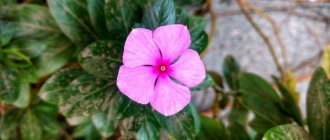Plant characteristics
The genus of this flower belongs to the Iris family. The deciduous form of the plant has a corm-like root system. Its stems are fleshy and elastic. They grow up to 1 meter, and at the top an inflorescence develops in the form of a spike. Growing in temperate climates requires a growth of up to 20 cm. The lanceolate shape of the leaf is slightly elongated, and it somewhat resembles a ribbon. The leaf is colored in a rich green shade.
By the end of May-June, bright flowers with a core of a contrasting shade (burgundy, yellow, purple) and bright petals begin to bloom. You can find sparaxis flowers in white, red, pink, burgundy, purple and other shades. In some varieties, in addition to the main shade, the petals have veins of a different color. Depending on the variety, the flower shape can be funnel-shaped or completely open.
On average, the diameter of a plant with six petals reaches 5 cm, and in the middle there is a pistil and 3 slightly twisted stamens.
Brief botanical description
Sparaxis (lat. Sparaxis) refers to bulbous deciduous plants; the genus includes 15 species of perennials. Fleshy, lanceolate-shaped leaves reach a length of 90-100 cm, forming a spikelet at the top.
The maximum height of peduncles is 60 cm, and to achieve spectacular group flowering, the bulbs need to be planted almost close to each other.
Sparaxis blooms in May and June - during this period the plant throws out a fairly powerful peduncle, on which there are star-shaped buds up to 5 cm in diameter, with a pistil in the middle.
The color of the flowers is characteristic - orange, yellowish, white or cream petals are separated from a bright yellow center by a dark ring. Sparaxis dries up at the end of August or early September, shedding its foliage and leaving only the underground part.
Only two types of sparkasis are used for cultural cultivation: tricolor (Sparaxis tricolor) and graceful (Sparaxis elegans).
There are about 20 varieties in total, with the most popular being “Jumbo Star Mix”, “Bilbifera”, “Tricolor Mix” and “Grandiflora”.
They look impressive not only in the photo - in flower beds, sparaxis instantly attract attention with their bright inflorescences
Gallery: sparaxis (25 photos)
Pests: ways to combat them
Sparaxis is affected by pests such as mealybugs, aphids, spider mites and thrips. Pest infestation most often occurs from neighboring infected crops.
- Spider mites feed on the undersides of leaves and damage leaves, causing them to turn yellow and dry out. A web forms on the back of the leaves. Control methods: treating the plant with a combined liquid of 0.1% karbofos and 0.3% ethersulfonate. This composition simultaneously destroys ticks and their eggs.
- The brown bug settles on shoots and leaves and feeds on plant sap. Control methods: get rid of the pest by treating the leaves of the plant with a cotton swab dipped in alcohol, or by treating with insecticides: “Fitoferm”, “Decis”, “Aktellik”, “Inta-vir”.
- Thrips are pests that primarily attack leaves. Light small spots form on the leaves. Over time, the affected leaves become shiny and wilt. Pests settle on the bottom of the plate. Control methods: remove the affected leaves and treat with insecticides - “Decis”, “Aktellik”.
- Aphids - colonies of small insects infect the stems and leaves of a plant, sucking out cell sap. Leaves and shoots become deformed and dry out. Control methods: treating the plant with a soap solution or special products containing permethrin. Such drugs include the drugs “Antitlin”, “Biotlin”.
Aphid
Known varieties
The genus of the flower is not varied. Scientists have identified only 6 varieties and up to 20 varieties. In Russia, only those varieties are grown that can develop in such a climate.
Sparaxis Tricolor (tricolor) is a plant with sword-shaped stems, the height of which reaches 50 cm. The inflorescence forms purple, red, white or yellow flowers with a bright core of a contrasting shade. Between the edges and the core you can see a ring of dark color (black or brown). This feature gave the flower its name. Based on tricolor sparaxis, scientists have developed several varieties:
- Bilbifera - tall inflorescence with yellow or snow-white flowers;
- Lord of Fire - blooms with scarlet petals and a black center;
- Low-growing mixture - plants on strong stems with yellow, red and white flowers;
- Grandiflora is a tall plant with bright inflorescences against a background of dark green foliage. Flowers can be purple, white, yellow, lilac. They are characterized by a strong aroma.
- Striped - bright orange petals contrast with the yellow center in an original way;
- Graceful - a plant up to 15 cm high, decorating the area with orange and yellow flowers.
Main problems when growing sparaxis
- Corms rot in the soil . This problem occurs when the soil is regularly waterlogged, as a result of which the tubers become sick with gray rot.
- The leaves have become dull and pale . There may be several reasons - a lack of mineral elements in the soil or the plant does not receive enough light.
- The leaves turn yellow and lose turgor . The problem occurs when there is a lack of moisture in the soil, and also if the flower grows in an area exposed to drafts and winds.
- The peduncles were distorted . There may be several reasons - planting a plant in an area that is illuminated by the sun most of the day on only one side, or the plant is constantly under the influence of winds and drafts.
Growing from seeds
Since the plant is demanding, its cultivation should be approached responsibly. This requires preliminary cultivation of seedlings in boxes with fertile soil. Sparaxis prefers to grow in a humid and warm climate, and therefore the crops are kept in greenhouses or conditions close to them.
Seeds are placed in the ground to a depth of 10 mm and covered with film until germination. Young growth is thinned out, leaving a distance of 2 cm between plants. Seedlings are regularly watered and kept in a well-lit place. When the plant reaches 6–8 cm, the seedlings are transplanted into open ground. It is important that the threat of frost has passed.
Planting sparaxis in a permanent place involves maintaining a distance of 15 cm (growing for cutting) or 45 cm (for decorating the garden). The first year after sowing, you should not expect flowering, since the plant takes root and gains mass after planting.
Planting sparaxis in open ground
What time to plant
The best place for growing sparaxis is the southern region: spring is warm, summer is hot, autumn comes late, and winter is relatively warm and mild. When this flower crop is grown in mid-latitudes, in late autumn its tubers are removed from the ground and stored for storage, and with the onset of spring they are planted again in open soil. It is recommended to plant tubers in mid-latitudes and colder areas from early to mid-May, after the soil is very well warmed up. In the southern regions, where in winter it never gets colder than 1 degree, tubers are planted before winter, in the last days of October.
Landing rules
The area suitable for planting should be well-lit, open and at the same time protected from gusts of wind. If sparaxis is planted in a shaded place, this will have an extremely negative impact on both the growth and development of the plant. It will grow best in fertile loam, but it can also be planted in other soil, as long as it is well-drained.
The bulbs should be buried 50–80 mm into the soil (depending on their size). The distance between holes and between rows should be about 8–10 centimeters. Planted tubers need abundant watering. Bushes planted in May will begin to bloom in August and will end with the onset of the first frost.
Reproduction of sparaxis
The bulbous plant can be propagated at home by seeds and corms. True, the option with seeds is allowed only in warm climates or when planting in a greenhouse, since seedlings must be preserved without digging for 2 years until flowering.
Seeds are sown in ordinary pots or in seedling beds in August. They need to be germinated warmly in a nutritious, loose substrate. After the emergence of seedlings, thinning is carried out. After strengthening the young shoots, they are transferred to greenhouses or open ground.
When and how to plant
Those who have already dealt with gladioli will find many similarities between these representatives of the flora. Considering what features the hero of this article has, planting sparaxis is most easily done using bulbs. You can buy them, or get them yourself.
To do this, when the time of autumn comes and flowering comes to an end, the bulb is dug up. By that time it had already been divided into several fragments. They are very carefully separated from each other. Here are the preparations for the future garden.
Initially, you need to let them dry. This will take five days. So that they retain their vitality, they cannot be left anywhere. Since these “embryos” will have to wait in the wings until spring, it is necessary to create suitable conditions for them.
Firstly, temperature. It should not be hot - maximum +10. But it’s not cold either, so look for suitable places in the house, it could be the cellar. Secondly, take care of the constant flow of fresh air into the room, ventilate it.
And finally, you can’t just lay them out on the floor; you need some kind of substrate. Sawdust is quite suitable for these purposes. If you did everything correctly, you don’t have to worry, the planting material will retain its properties for up to three years.
When spring is around the corner, the sparaxis bulbs must survive the move. To begin with, bring them to where it is warmer, and significantly. Average room temperature in a living space is fine. The tubers should spend a couple of weeks in the new place.
Afterwards, you need to decide where you will plant - in a pot, or directly outside. But in any case, you need the right mixture for this. The set of components will be as follows: loam plus sand (the ratio should be 50/50), plus some kind of organic fertilizer.
Compost can serve as the latter; humus will also work. In addition, a prerequisite is a drainage layer. Make sure it is at least five centimeters thick.
Both expanded clay and ordinary gravel will work here. The hole should be small, only ten centimeters deep, but the distance between the planted tubers needs to be twice as large.
If we talk about when to plant sparaxis, then you also need to remember that this flower is heat-loving, therefore, if you do not live in the warmest latitudes of our country, do it in March.
Then at the height of summer you will be pleased with the bright inflorescences. If the climate in your region is mild, you can plant in the fall. Then, already in May you can count on flower beds pleasing to the eye. And by mid-summer such buds will fade. The main thing to remember here is that if the temperature drops below zero, the matter is lost, the tubers will die.
When you want, you can resort to another way to acquire such beauty in your garden - buy seeds. But get ready, it won't be that simple. If you at least allow the temperature to drop, you can say goodbye to this idea.
To begin, take a box or a special flowerpot. The container must be filled with suitable soil. The seeds do not need to be deepened too much; a centimeter will be enough; you can lower them into the ground to a shallower depth.
Next, you need to wrap all this equipment in film and leave it alone for a while, but only where it is warm. Do not forget about moisture, it must be supplied in sufficient quantity. Have you noticed the first shoots? – take care of thinning immediately.
Provide a distance of two centimeters between plants. The next step is to wait until the seedlings reach a height of eight centimeters. Watering and sunlight should be provided at this time. When the plants reach the desired size, you can move them to their permanent location. But remember that after transplantation, no frost.
These flowers look best in a group. Therefore, you should not scatter plants individually throughout the garden. Arrange a whole “island” of colorful inflorescences. If we are talking about very long varieties, then take a reserve of 10 centimeters when planting; you should not plant them closer.
If you like plants that are not so tall, then four centimeters will be enough. But there should be no trees nearby that will create shadow, because your flowers need more warmth and light.
On-site care
Originating from hot countries, sparaxis flowers require growing conditions as close as possible to tropical ones. Special care is also required:
- The flower is not afraid of hot rays, and with little shading it can lose the intensity of flowering. That is why the plant should be planted in a sunny area. Planting near trees, bushes and walls is not recommended.
- During the period of active development, the plant is very afraid of drought. That is why regular watering is an important condition for care. In dry spring, watering should be abundant and frequent. It is not difficult to understand that a flower needs watering - a small amount of foliage, the absence of buds and the yellow color of the leaves.
- Sparaxis likes high humidity. That is why, when caring for a flower, it should be sprayed several times a week. It is better to do this early in the morning to prevent leaf burns. Settled water is more suitable for such care.
- When growing sparaxis in flower beds, it is enough to apply fertilizer for bulbous plants once a month. No fertilizing is needed in the fall.
- Growing in containers requires slightly different care. Such flowers are watered more often and fed. Mineral fertilizers are added to the water twice or thrice a month (10 g per 5 liters).
Diseases and pests
Despite the fact that the flower loves moisture, a constant overdose of liquid can lead to rot affecting the plants. Another ailment that can affect greenery is chlorosis. Its signs are yellowing of leaves and cessation of growth.
Iron deficiency can lead to such symptoms. To overcome the disease, arm yourself with chelate-based products. With their help, you need to treat the plant susceptible to the disease.
Gardeners are also not immune from such scourges as pests. For example, spider mites. This is where insecticides come to the rescue. You can tell whether these insects have settled on a flower by the characteristic spots; they are either light green or beige. If the pest has chosen the place for a long time, then the web is attached to all of the above.
Burrowing insects such as mole crickets can damage the bulbs. They just gnaw on the roots. To avoid this situation, set up traps for harmful bugs. These should be small holes next to the flower beds.
Place manure in these holes. True, cow milk will not be as good for these purposes as horse milk. Then all the insects will flock there like bees to honey. And when they all accumulate in one place, it will be much easier to destroy them. If suddenly this bright representative of the garden “refuses” to bloom, the reason may be a cool or too cloudy summer.
King of Landscaping
It is necessary to take into account that one bush does not look good in a flowerbed, and if it is planted among other flowers, it will get completely lost.
Sparaxis clearings made from varieties of different shades are considered the most effective. This is an unforgettable sight. In rock gardens, the flower looks gorgeous next to coniferous and succulent plants. When forming a stepped composition, it is better to place low-growing plants in the foreground. In small areas it is worth placing flowerpots with sparaxis near gazebos or verandas.
Your efforts will be appreciated!
The impressive beauty of sparaxis inflorescences
Sparaxis are far from the largest of the representatives of bulbous plants. The height of the peduncles of this exotic plant reaches only 60 cm, while the bulb does not produce many leaves and does not create beautiful rosettes. In order to create a beautiful “spot” or group from sparaxis, the bulbs must be placed very tightly, planted almost next to each other.
Sparaxis is a genus of the Iris family (Iridaceae), which includes 15 species of perennial herbaceous corms.
Sparaxis cannot boast of a wide variety of species. This is a plant with several growth forms, which today are divided into 4-5 wild natural species. Only two of them are used in landscape design - tricolor sparaxis (Sparaxis tricolor) and graceful dwarf sparaxis (Sparaxis elegans). Smooth, lanceolate leaves without edges only visually emphasize the rather powerful peduncle. But any shortcomings of greenery, including small numbers, are more than compensated by the beauty of flowering. In sparaxis it is not just decorative, but colorful and extravagant. Flowering begins in regions with mild winters in late spring and early summer, but in the middle zone and to the north - much closer to autumn, in colorful August or September. The flowers are star-shaped, up to 5 cm in diameter. A dark ring separates the bright yellow center with stamens from the main color of the petals, which creates an almost graphic effect. In different sparaxis, monochromatic orange, yellow, pink, white, and cream colors are replaced by various variegated combinations that seem to be hand-painted patterns on the petals. In dwarf sparaxis, the colors are more limited: the flowers are either white or orange.
Sparaxis elegans. James Gaither
In garden design, sparaxis are used:
- to create colorful spots on the lawn and clearings of ground covers;
- as luxurious accents in the foreground of flower beds and mixborders;
- in large groups and in monoflowers;
- in flowerbeds of bulbous and corm crops that require digging;
- for decorating rockeries and front gardens;
- as a cut crop;
- for decorating rooms, greenhouses, winter gardens.
General description and characteristics of the sparaxis flower
Sparaxis belongs to the Iridaceae family and belongs to the genus of corms. In nature, it is found only in southern Africa, where it blooms along the banks of reservoirs. One species (Sparaxis tricolor) has been introduced to California.
https://youtube.com/watch?v=DT5WoRLR12A
https://youtube.com/watch?v=DT5WoRLR12A
In African conditions, sparaxis grows up to a meter, but when transferred to our latitudes it produces a peduncle 50-60 centimeters high. Characteristics of Sparaxis:
- The basal rosette consists of smooth lanceolate foliage of a rich green color, like many irises.
- Corm.
- Dwarf species grow up to 15 centimeters, the rest - 50-60 centimeters.
- Flowers up to 5 centimeters in diameter. The shape is star-shaped or funnel-shaped. The pistil is pronounced, strongly protruding, 3 stigmas. The color of the petals in most of them has contrasting transitions.
The flowers are not large, but the pronounced contrast of color makes the blooming sparaxis the main decoration of any site. The petals are painted in 2-3 colors, the transitions seem to be drawn with clear lines. Various colors - yellow, orange, purple, white.
In conditions similar to African ones, sparaxis blooms in the spring and delights with a riot of colors all summer. In the realities of the Middle Zone, with the need to remove the bulbs from the soil for the winter, flowering begins at the end of summer.
How to plant hazel grouse bulbs
Using tubers in open ground
The dug up tubers of an already wilted plant are cleaned and stored in a dry room at a temperature not exceeding 9 degrees. At the same time, they are insulated with sawdust, straw, peat, while ensuring good circulation of fresh air. In such conditions, the bulbs can remain for up to 3 years without deteriorating. Before planting, the nodules are warmed up, increasing the temperature in the storage to 25 degrees. At the beginning of the growth of sparaxis, you should be wary of drought
Breeding in pots
With this method, the nodules are planted in early autumn in 2-3-liter pots. No more than four copies of sparaxis should be placed in one such container. The pots are placed on the windowsill, watering the plants well.
Drafts harm plantings. In just three months, the window sill will be filled with colorful tropical flowers.
Outlandish garden decoration
In order for sparaxis to fully reveal its decorative properties, it is necessary to plant it in large, dense tracts. Single flowers can get lost in the garden, but dense multi-colored plantings allow you to create an interesting composition solely from sparaxis.
It is important to remember that by the end of summer it will completely wither and the void will need to be filled with other plants. It takes well to the proximity of thyme, phlox, tigridia, and sedum. Combines well with lawn grass and ground cover green plants. In this case, the effect of a natural lawn is created.
Compact varieties are suitable for planting in pots to decorate a terrace or balcony. Bright flowers are also planted in rock gardens or decorated with evergreen shrubs and dwarf trees.
Types and planting of plants
We recommend that you read
Like all tropical plants, the flower is very picky: it loves warmth and does not tolerate frost at all. Achieving flowering is a rather difficult task, but with proper care it is feasible. There are several common varieties suitable for the varied Russian climate:
- 1Tricolor (tricolor). The most common type, which is distinguished by durable stems and mixed colors of inflorescences.
- 2Bilbiefera. The tallest of all representatives of the species. Loves sandy and calcareous soils. The flowers are mostly white.
- 3Grandiflora. A favorite of gardeners because of its pleasant fragrant aroma.
The flower prefers nutritious soil. A thick layer of drainage must be laid at the bottom. It is recommended to plant the tubers on a sandy “cushion” that will absorb excess water. The holes are dug at a distance of 7-10 cm from each other. Experts recommend planting 60-80 specimens at once, then the garden will be decorated with flowers.
The location must be open, exposed to direct sunlight. It is advisable to plant plants away from the shade; it is also necessary to avoid drafts and strong winds. The landing time of Sparaxis directly depends on the climate:
- 1In warm winter conditions, planting is carried out in early November. In this case, flowering can be expected as early as May. The bulbs are planted to a depth of 7-8 cm. For the winter, the soil should be covered with a layer of peat or leaves (7 cm), which is removed in early March.
- 2In cold winter conditions, the bulbs are planted in the ground in late April-early May. In this case, the soil must warm up to +15°C. It should be buried to a depth of 5-6 cm. You can expect flowering in early August.
It is important to know that tubers of tropical plants die at temperatures below 0°C. This fact should be taken into account when choosing a landing time.
After the flowers fade, Sparaxis needs to be dug up. It is stored in a dry place until the leaves are completely dry. Only then can the sheets be removed. Throughout the storage period, the bulbs must be carefully checked. All rotten, dried or damaged bulbs should be removed immediately.











